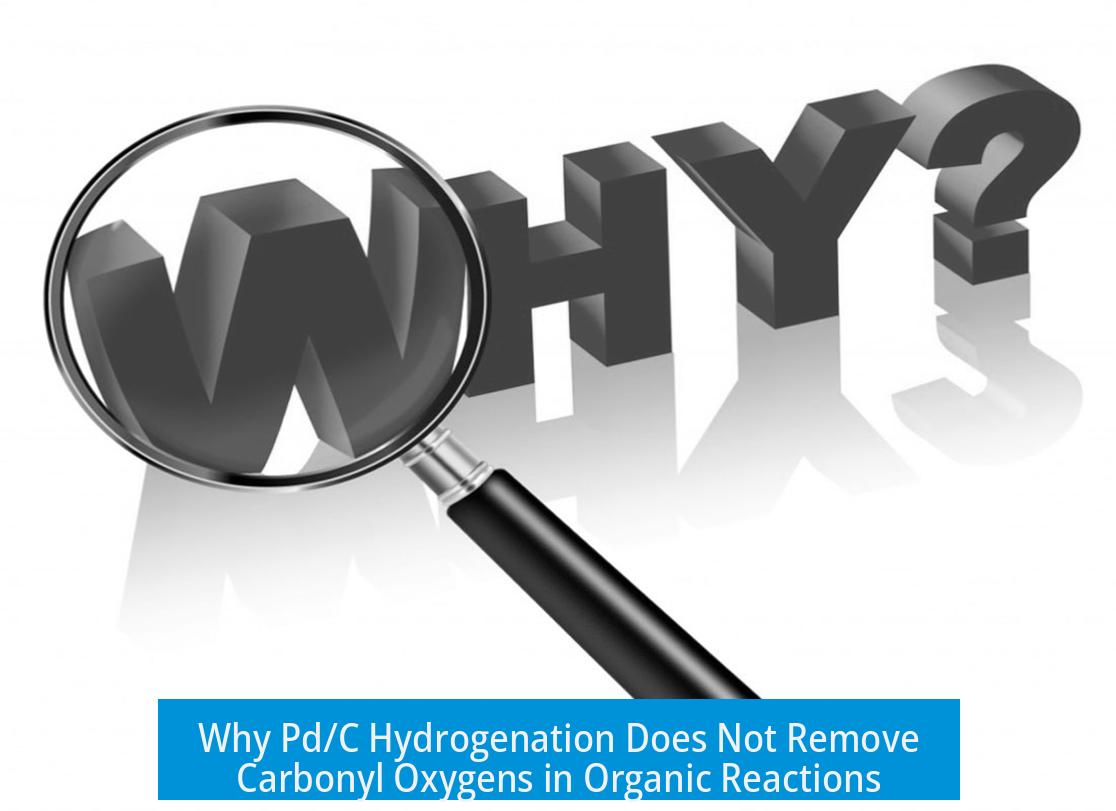Why Doesn’t Pd/C Hydrogenation Remove Carbonyl Oxygens?
Pd/C hydrogenation does not readily remove carbonyl oxygens because the polar C=O bond is resistant to reduction under standard conditions, unlike non-polar carbon-carbon double and triple bonds which Pd/C efficiently hydrogenates.
Bond Characteristics Affect Reactivity
Palladium on carbon (Pd/C) catalyzes hydrogenation by adsorbing and activating hydrogen and the substrate. It favors non-polar π bonds such as those in alkenes (C=C) and alkynes (C≡C). These bonds lack significant polarity, allowing Pd to interact and reduce them rapidly.
The carbonyl group (C=O) differs fundamentally. The bond is highly polar because oxygen’s electronegativity creates a strong dipole. This polarity limits the ability of Pd/C to adsorb and activate the carbonyl group for hydrogenation as effectively as non-polar double bonds.
Hydrogenation Efficiency on Functional Groups
- Non-polar C=C and C≡C bonds are quickly hydrogenated by Pd/C catalysts.
- Carbonyl C=O bonds undergo much slower hydrogenation and typically are not fully reduced to remove the oxygen.
Under usual conditions, Pd/C adds hydrogen across the carbonyl double bond to form alcohols rather than removing the oxygen completely. The conversion of a ketone or aldehyde to a hydrocarbon (CH2) group requires stronger or modified conditions.
Special Conditions for Carbonyl Reduction
In certain cases, ketones conjugated to aromatic rings may undergo more extensive reduction under acidic and heated conditions. This combined environment promotes removal of the oxygen atom and converts the carbonyl into a methylene unit (CH2). This process is not straightforward and often requires patented or specialized procedures beyond routine Pd/C catalysis.
Summary of Pd/C Behavior with Carbonyls
| Bond Type | Polarity | Reduction by Pd/C |
|---|---|---|
| Alkene (C=C) | Non-polar | Rapid hydrogenation |
| Alkyne (C≡C) | Non-polar | Rapid hydrogenation |
| Carbonyl (C=O) | Polar | Slow hydrogenation, usually forms alcohol; complete oxygen removal rare |
Key Takeaways
- Pd/C hydrogenation favors non-polar carbon-carbon π bonds over polar carbonyl C=O bonds.
- The polarity of the carbonyl bond prevents easy adsorption and activation by Pd/C under normal conditions.
- Typical Pd/C hydrogenation converts carbonyl groups to alcohols rather than removing oxygen.
- Complete reduction of carbonyl oxygen to CH2 requires acidic, heated conditions and often applies to conjugated ketones.
Why does Pd/C hydrogenation reduce C=C bonds more easily than C=O bonds?
Pd/C targets non-polar carbon-carbon double bonds effectively. The C=O bond is polar due to oxygen’s electronegativity, making it less reactive under typical Pd/C conditions.
Can Pd/C hydrogenation completely remove the oxygen from a carbonyl group?
Normally, no. Standard Pd/C conditions only slowly reduce carbonyls and do not remove the oxygen entirely. Complete reduction to CH2 requires harsher conditions.
Under what conditions can Pd/C hydrogenation remove the oxygen from ketones?
Ketones conjugated to aromatic rings may be fully reduced under acidic and heated conditions using Pd/C. This allows conversion of the C=O group to methylene (CH2).
Why is the carbonyl C=O bond reduction slower with Pd/C?
Its polarity limits adsorption and activation on the Pd surface. The catalyst prefers non-polar π bonds that interact more readily, delaying carbonyl reduction.
Does Pd/C affect aldehydes and ketones the same way?
Both aldehydes and ketones show slower reduction due to their polar C=O bonds. Neither is removed quickly without special conditions.




Leave a Comment